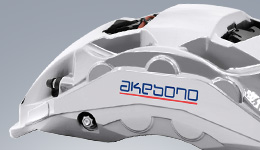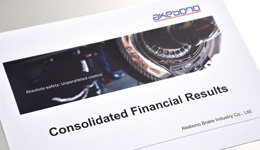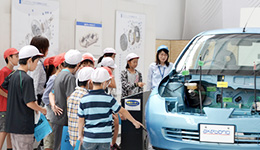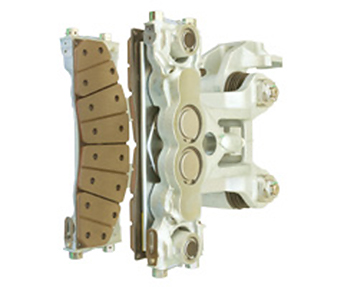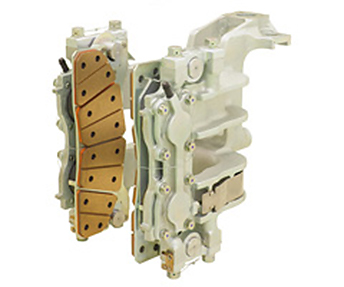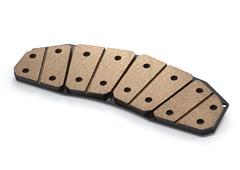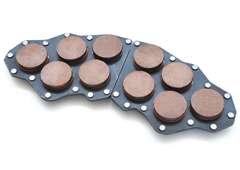Brakes for Rolling Stock
Akebono develops and manufactures the brakes for bullet trains and conventional trains. Especially, Akebono has approximately 50%* share in Japanese bullet trains. Akebono rolling stock brakes are also used in high speed trains in overseas.

Akebono develops and manufactures the brakes for bullet trains and conventional trains. Especially, Akebono has approximately 50%* share in Japanese bullet trains. Akebono rolling stock brakes are also used in high speed trains in overseas.
Akebono has played a significant role in the development of rail vehicles in Japan. In 1952, at the request of Japanese National Railways (now JR Group), Akebono began development of rail vehicle products. As a result, we started the production of wear pads employing the synthetic resin technology after their designs were accepted by JNR. After our resin brake shoes and disc brake lining were approved for use in "Kodama" and "Asakaze" express trains in 1959, Akebono products became widely used in various rail vehicles. Akebono currently enjoys a large market share of brake installations on Japanese bullet trains, including the most recent N700 series.
Disc Brakes for Bullet Trains
After being installed in JR-Central 300 series "Nozomi" bullet train, Akebono disc brakes have been used on multiple bullet trains of JR group companies as well as on super-express trains in Taiwan and China.
In bullet train disc brakes, the lining (friction material) is hydraulically pushed against the disc to control wheel speed.
A single train car has between 8 and 16 brakes installed, so in case of the N700 bullet train which has 16 cars, a total of 128 disc brakes are used, each weighing about the same as an adult human.
Depending on the way friction material is pressed against the disc, there are two types of railroad disc brakes: floating caliper type and fixed caliper type. Akebono is producing both types. In addition, both mechanical parts and friction materials for railroad brakes are designed and produced in-house, allowing Akebono flexibility to support all customer requirements.
Akebono technology plays a big role in bullet trains, which need to be safely and reliably stopped when traveling at speeds up to 300km/h (185mph).
Disc Brake Linings for Bullet Trains
Akebono disc brake linings are installed in multiple models of bullet and super-express trains. These linings are pushed from both sides against the disc rotor (disc-shaped metal part attached to the wheel) to generate friction and safely stop train cars.
To handle high velocities and loads, bullet train brake linings are made using sintering process, which assures high strength as well as excellent heat and abrasion resistance. Performance of our linings is evaluated using in-house high speed dynamometers. Akebono continuously strives to use least environmentally hazardous materials in production of our parts while providing best possible friction characteristics.
Even-Contact Pressure Disc Brake Linings for Bullet Trains
E5 type bullet trains “Hayabusa” of JR East use Akebono’s even-contact pressure disc brake lining which satisfy increased needs of high speed running.
Even-contact pressure disc linings are new type of linings which can push the linings to rotor surfaces with even pressure. The brakes allow the safe operation and stable braking at high speed more than 300km/h. The separate linings are made of sintered alloy and environmentally low impact materials.
Akebono keeps on proposing ideal solutions by anticipating future customer needs.
Disc Brake Linings for Conventional Trains
Akebono disc brake linings can be found on a wide range of regular and express trains in Japan, belonging both to JR group companies and private carriers.
Since the frequency of brake application is higher for conventional trains, synthetic resin-based linings that are less likely to damage the rotor when pressed against it are used here. For use in areas that experience snowfall, Akebono has assembled an assortment of unique solutions that meet all customer needs, such as linings with sintered alloy blocks adapted to stronger loads.
Since the time Akebono products were first used for "Kodama" express train in 1958, we continuously strive to develop our products using least environmentally hazardous, high durability materials that are in line with the times and that satisfy the needs of our customers.
Brake Shoes for Railroad Train
These Brake shoes are devices that slow or stop a wheel by being pressed directly against the wheel tread (the surface that comes in contact with the rail). Apart from braking functions they also serve to keep the tread clean and a single wheel can have 1 or 2 of these installed.
This type of brake is called "tread brake", as opposed to disc brakes that squeeze a metal disc from both sides.
The wheel surface that the shoes are pressed against is strongly affected by the condition of the rail, but brakes need to reliably stop the vehicle under any circumstances, including in rain or snow.
Since the frequency of brake application is high for conventional trains, these shoes are produced using synthetic resins as the friction material base, which decreases the likelihood of damage to the wheel tread. As a sole manufacturer of sintered alloy brake shoes in Japan, Akebono provides a range of sintered products for use in high-speed express trains or in areas experiencing heavy snowfall. We also offer a full lineup of hybrid products combining the advantages of sintered alloy and synthetic resin materials.
Akebono continuously strives to develop products using least environmentally hazardous, high durability materials that are in line with the times and satisfy the needs of our customers. We provide braking solutions for a wide range of rail vehicles, such as electric and diesel locomotives as well as passenger and freight train cars.



